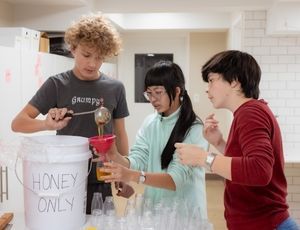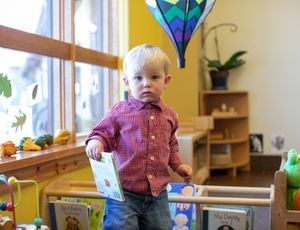Have you noticed that we put a lot of emphasis on the mental and physical development of our children? Still, we usually do not concentrate our energy on helping children connect physically and mentally. This is because many consider them separate processes. In this article, we will share Dr. Montessori’s discovery of the vital role the hand plays in developing intelligence and how to foster the mental-physical connection with our children.
Using our hands is an everyday process; being able to control our movements and use our hands for purposeful actions is a process that starts the moment we are born. First, we start practicing and controlling our gross motor movements, and as we grow up and have opportunities to repeat, we will begin developing and refining our fine motor skills. Our hands serve as instruments to connect with the world and change it; children need plenty of opportunities to manipulate and gather information from the environment. The hand reports to the brain, the brain guides the hand, and these loops continue, resulting in the development of the brain and function of the hand.
Once children start walking, their hands are free to explore the environment, and they’ll use them as much as the environment allows it. They open drawers, take out every single object they find, manipulate them, observe them, and put them back in the drawer again. For toddlers, it is not enough to absorb the environment through their eyes anymore; they want hands-on experiences. That is why in a Montessori school, you will observe many materials that offer rich sensorial experiences to the children. In the same fashion, you can prepare your house environment for your child to keep working with his hands as much as he wants.
How can You Foster a Hand and Brain Connection at Home?
Trust your child. If you notice your child wants to hold a small glass cup or wants to eat soup with a spoon, trust that he can do it. He knows what his body is capable of doing. Show him patiently how to do it for the first time and step back so he can practice at his own pace and desire. Sometimes we underestimate the potential of our children. For instance, we keep offering drinks in cups with lids, straws, or even bottles, but the truth is that a child as young as five months can start practicing how to drink from a small open cup independently.
Allow repetition. Fine motor skills need strong muscles, and like every muscle in their body, they need practice. Do not expect your child to use the spoon for the first time without spilling a single drop of soup. He needs to practice to strengthen his muscles and coordinate the instructions his brain is sending to his mind.
When the hand moves, the mouth does not. This is a big one. When you spend time with your toddler showing him how to do a puzzle, insert beads on a string, stir the cake mix, etc. make sure you do not speak while you are showing him how to move his hands. This is very important. Children are attracted to language, so if you start talking while moving your hands, your child automatically will look at your lips moving and ignore the slow hand movements you are making. It does not mean you need to be silent for ten minutes with your toddler. Just give him time for you to show him how to do something for the first time with his hands. Allow him to watch your movements closely and be slow so he can process every single detail of your hands. This is a principle that every Montessori trained guide puts into practice with every child, every day.
Freedom of time. Give your child as much time as needed to explore an item. Avoid giving him too many things rapidly since it can interfere with his concentration and motivation. Plus, this does not allow him to gather enough information about the object.
Simple Activities for Your 21-Month-Old
- Open and close a lock with a key
- Use a zipper
- Button his clothes
- Comb his hair
- Spread butter on bread (hummus, avocado, jelly or any other snack he likes)
- Independently eating using spoons and forks.
- Peel a banana, clementine, or any other fruit with a soft peel.
- Wipe the table or any other furniture
- Wipe glass doors or windows
- Open and close doors
- Wash his hands independently
These are just a few ideas that foster the hand-brain connection, plus the development of independence. When toddlers achieve a goal, they feel very good about it, and there is an immediate internal satisfaction that impacts their self-image positively.
Item of the Month
MUNAJI Rounded Child-size Scissors
These scissors are the perfect size for your toddler’s hands. They have a plastic cover so they can store them safely. Show your child how to cut strips of paper or brown leaves from plants. Watch him practice how to place his fingers and allow repetition.
Link to buy them at Amazon.com:
https://www.amazon.com/Westcott-Classic-Scissors-Blunt-15967/dp/B00D05BJDE/ref=sr_1_2?dchild=1&keywords=rounded+child-size+scissors&qid=1594822820&sr=8-2
Quote of the Month
“We see that the development of the hand is connected with the development of the intelligence in man and if we look at history, it is connected with the development of civilization.”
-Maria Montessori, The Absorbent Mind
Have a Little Extra Time?
Bead Stringing by Montessoriguide.com
Enjoy this six-minute video where you will be able to observe two toddlers concentrating with small objects like beads, strings and flowers. They make very refined movements and connect their brains with their hands. They are in control of the material and use it successfully.
Link to watch it at Vimeo:
https://vimeo.com/121142494



